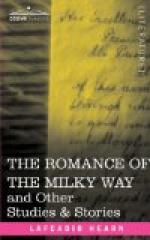Modern dictionaries ignore the uncanny significations of the word Yanari,—only telling us that it means the sound of the shaking of a house during an earthquake. But the word used to mean the noise of the shaking of a house moved by a goblin; and the invisible shaker was also called Yanari. When, without apparent cause, some house would shudder and creak and groan in the night, folk used to suppose that it was being shaken from without by supernatural malevolence.
Tokonoma ni
Ik[’e]shi tachiki mo
Taor[’e]-keri;
Yanari ni yama no
Ugoku kak[’e]mono!
[Even the live tree set
in the alcove has fallen down; and
the mountains in the hanging
picture tremble to the quaking
made by the Yanari![50]]
[Footnote 50: The tokonoma in a Japanese room is a sort of ornamental recess or alcove, in which a picture is usually hung, and vases of flowers, or a dwarf tree, are placed.]
X. SAKASA-BASHIRA
The term Sakasa-bashira (in these ky[=o]ka often shortened into saka-bashira) literally means “upside-down post.” A wooden post or pillar, especially a house-post, should be set up according to the original position of the tree from which it was hewn,—that is to say, with the part nearest to the roots downward. To erect a house-post in the contrary way is thought to be unlucky;—formerly such a blunder was believed to involve unpleasant consequences of a ghostly kind, because an “upside-down” pillar would do malignant things. It would moan and groan in the night, and move all its cracks like mouths, and open all its knots like eyes. Moreover, the spirit of it (for every house-post has a spirit) would detach its long body from the timber, and wander about the rooms, head-downwards, making faces at people. Nor was this all. A Sakasa-bashira knew how to make all the affairs of a household go wrong,—how to foment domestic quarrels,—how to contrive misfortune for each of the family and the servants,—how to render existence almost insupportable until such time as the carpenter’s blunder should be discovered and remedied.
Saka-bashira
Tat[’e]shi wa tazo ya?
Kokoro ni mo
Fushi aru hito no
Shiwaza naruran.
[Who set the house-pillar
upside-down? Surely that must have
been the work of a man with
a knot in his heart.]
Hidayama we
Kiri-kit[’e] tat[’e]shi
Saka-bashira—
Nanno takumi[51] no
Shiwaza naruran?
[That house-pillar hewn in the mountains of Hida, and thence brought here and erected upside-down—what carpenter’s work can it be? (or, “for what evil design can this deed have been done?")]
[Footnote 51: The word takumi, as written in kana, may signify either “carpenter” or “intrigue,” “evil plot,” “wicked device.” Thus two readings are possible. According to one reading, the post was fixed upside-down through inadvertence; according to the other, it was so fixed with malice prepense.]




